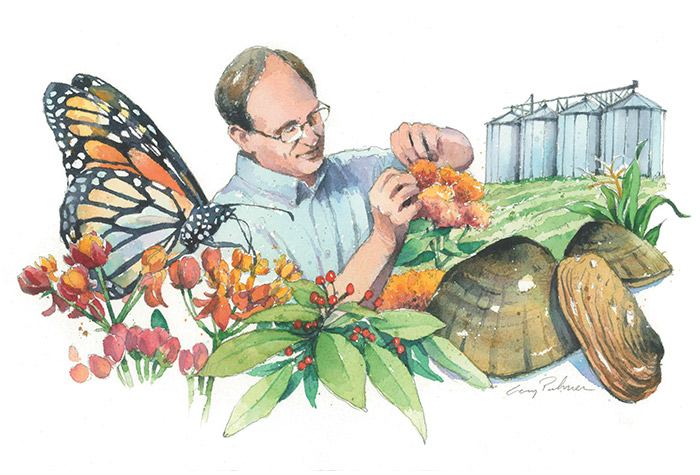Uncertainty and litigation—those are among the results of the long history of conflict between the U.S. Environmental Protection Agency, which oversees pesticide regulation, and the U.S. Fish and Wildlife Service and National Marine Fisheries Service, which administer the Endangered Species Act (ESA). This conflict affects the agriculture industry’s ability to plan and invest in research and development, and it also threatens growers’ access to important tools.
“It’s a very complex regulatory matter that has been difficult from a science, legal and administrative viewpoint for many years,” says Laura Peterson, head of federal government and industry relations at Syngenta. “Our company is committed to doing what we can to protect the environment and provide cutting-edge tools to farmers. To achieve these mutual goals, we encounter many challenges and opportunities—from developmental to approval processes—that ensure we address all U.S. environmental regulations.”
To help find a better way forward with greater regulatory certainty, Syngenta is participating in conservation projects that benefit certain endangered and candidate species.
“These projects focus on identifying ways for landowners to improve habitats for endangered and candidate species and then measuring the benefits for the species,” says Ya-Wei Li, director for biodiversity at the Environmental Policy Innovation Center. “Those benefits can address some of the potential impacts of pesticide use calculated from models, so the species is better off and the process for registering pesticides is more efficient.”
The projects are optional for growers and consistent with what they are already doing on their land. “Maybe they’re doing X, Y and Z, but there are additional practices they don’t have funding for, though they agree those would be good to do,” Li says. “Syngenta collaborates with conservation groups and academics in providing resources, guidance and technical support, which enables growers to carry out those practices.”
Endangered Species Project: Delta F.A.R.M.
A conservation project that Syngenta supports is with Delta F.A.R.M. (Farmers Advocating Resource Management), an association of Mississippi growers and landowners. The objective is implementation of agricultural practices that will increase habitat for three endangered species in the Yazoo Mississippi River Delta in northwest Mississippi: two mussels and the pondberry plant. Implementation began last fall.
“In the past, we’ve regulated threatened or endangered species, and then we’ve regulated pesticides separately, and the overlap has not been there. We’re looking at how to do both without impacting either.”
Growers haven’t felt an impact, says Trey Cooke, the organization’s executive director, and he doesn’t expect they will. “The conservation measures we’re implementing are not taking acres out of production—the farmers are adding conservation measures that they are already accustomed to, but this project’s providing them incentives to install them.” These measures include sediment retention structures, cover crops and overseeding of existing buffers with pollinator-friendly plants.
He’s hopeful about both the results and the model this project might offer. “In the past, we’ve regulated threatened or endangered species, and then we’ve regulated pesticides separately, and the overlap has not been there,” he says. “We’re looking at how to do both without impacting either.”

Candidate Species Project: Monarch Butterflies
Another conservation project involves the Iowa Monarch Conservation Consortium, which seeks to establish approximately 480,000 to 830,000 acres of monarch habitat by 2038. The monarch is not listed as endangered, but its population has declined over the last 20 years in North America. The consortium seeks to support species recovery through voluntary efforts and avoid the need to list the monarch under the Endangered Species Act.
The loss of milkweed in Iowa and other Midwest farm states has contributed to the butterflies’ decline. “Everybody has a role to play in helping to increase the amount of monarch-breeding habitat in the state—in a way that is consistent with agricultural production,” says Steve Bradbury, professor of natural resource ecology and management at Iowa State University and a member of the project’s research team leadership. “We’re doing research to better understand how females move across the landscape and how many eggs they produce, and whether a few really big patches of habitat or lots of small habitat patches produce more monarchs in the subsequent generation. Another major theme of our research has to do with the potential risks that pesticide use could have on reproductive performance and population trends, because we’re clearly going to be establishing habitat in close proximity, at least in Iowa, to crop production.”
No land is coming out of production; the conservation efforts focus on spots where farmers aren’t growing corn and soybeans. “With support from the Iowa Pork Producers Association, we’ve also researched habitat establishment around hog production facilities, where people would otherwise be mowing—so that saves time and money, too,” Bradbury says.
A New Approach
In these types of conservation projects, the goal is to develop conservation practices as tools in an improved process that is timelier and more predictable, supports innovation and access to crop-production inputs while protecting farming practices, and ensures protection for endangered species. That would create a true win-win situation—and that’s why Syngenta continues to invest in such conservation programs.
“Syngenta is a leader in looking for solutions to these complicated issues between pesticide regulation and endangered species,” Cooke says. “Syngenta is taking a can-do approach of saying, ‘Let’s work together for an outcome that helps us all.’”